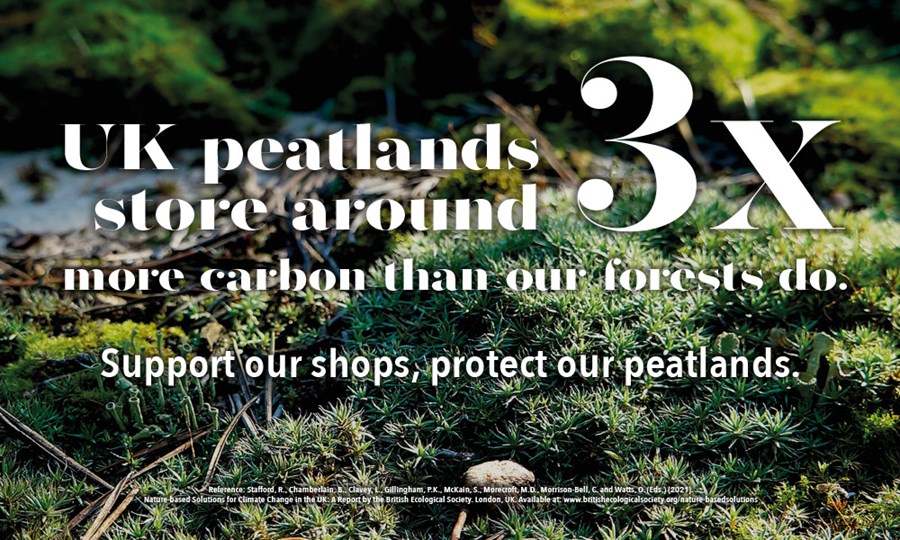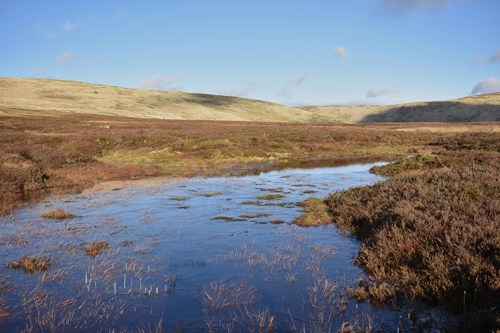Project Peatlands
Support our shops, protect our peatlands.

Project Peatlands
Project peatlands is now complete!
We are pleased to say that peatland restoration work at Gameshope Loch in the Scottish Borders is now complete. By choosing to shop and dine at St. Pancras International, you have helped restore a vital ecosystem that globally stores more Carbon Dioxide than trees do.
Since we launched Project Peatlands in June 2021, the campaign has:
- Prevented a projected 3.33 million kg CO2e from entering the atmosphere through peatland restoration
- Revitalised a unique ecosystem, supporting a greater diversity of wildlife including iconic species like black grouse and hen harriers
- Significantly increased the area’s capacity to store clean water and decreased the risk of wildfire
Our customers have made this possible. Every purchase you made with our retailers over the last 15 months has contributed towards the success of this campaign, from lattes to loafers, hampers to hardbacks, all helped make a big difference to the environment.
Recognising this success, the campaign has recently been awarded ‘Highly Recommended’ status at the Global Travel Retail Awards, voted on by over 2000 consumers. Thank you to our partners Forest Carbon for facilitating the restoration work, and our customers for making it happen!
Watch this space for our next exciting project…
A little on Peatlands
Functioning peatland ecosystems are some of the most carbon rich terrestrial ecosystems on earth, storing up to 30 times more carbon per hectare than a healthy tropical rainforest.[1] Globally peatlands lock-up an estimated 550 billion tonnes of CO2e.[2] In the UK, it’s estimated that our peatlands store around 3x more carbon than all of our forests.[3]
 Healthy peatland ecosystems also play host to a biodiverse ecosystem of mosses, insects, moths, amphibians, reptiles, flowering plants, fungi, birds and butterflies. A lowland bog may hold over 3000 insect species, 800 flowering plants and hundreds of types of mosses creating a rich ecological fabric. Sphagnum mosses are the keystone bog species, in part because they can hold 20 times their own dry weight in water, ensuring the ground remains waterlogged most of the time. In terms of the carbon stored, a 15cm layer of living sphagnum can hold the up to 50 tonnes of carbon per hectare.
Healthy peatland ecosystems also play host to a biodiverse ecosystem of mosses, insects, moths, amphibians, reptiles, flowering plants, fungi, birds and butterflies. A lowland bog may hold over 3000 insect species, 800 flowering plants and hundreds of types of mosses creating a rich ecological fabric. Sphagnum mosses are the keystone bog species, in part because they can hold 20 times their own dry weight in water, ensuring the ground remains waterlogged most of the time. In terms of the carbon stored, a 15cm layer of living sphagnum can hold the up to 50 tonnes of carbon per hectare.
However, UK peatlands are in desperate need of support, around 80% of them are currently damaged, drying out and oxidising, releasing vast quantities of greenhouse gases that had been locked up for hundreds or even thousands of years.[4]
In fact, UK peatlands currently emit an estimated 23 million tonnes of CO2e each year[5] - that's the equivalent to around half of all the combined carbon reduction efforts made annually. Preventing further damage to our peatlands and restoring their healthy function is therefore critical if the UK is to hit its climate targets.
Gameshope Loch Peatlands
Gameshope Loch Peatlands is owned and managed by the Borders Forest Trust. A combination of bare peat revegetation, hagg reprofiling and gully blocking will allow the water table to rise and peat-forming plant species to recolonise the area. These plants lock up carbon when they die and become stored, partially decomposed, as layers of peat below the growing layer of mosses.
By restoring the peatlands, this project will not only reduce greenhouse gas emissions from the degraded mires, it will also allow the landscape to store more water and support a greater diversity of wildlife, including iconic species like black grouse and hen harriers.
Find out more about Gameshope Loch Peatlands.

References:
[1] www.iucn.org/resources/issues-briefs/peatlands-and-climate-change
[2] www.iucn.org/resources/issues-briefs/peatlands-and-climate-change
[3] Stafford, R., Chamberlain, B., Clavey, L., Gillingham, P.K., McKain, S., Morecroft, M.D., Morrison-Bell, C. and Watts, O. (Eds.) (2021). Nature-based Solutions for Climate Change in the UK: A Report by the British Ecological Society. London, UK. Available at: https://www.britishecologicalsociety.org/policy/nature-based-solutions/
[4] www.ons.gov.uk/economy/environmentalaccounts/bulletins/uknaturalcapitalforpeatlands/naturalcapitalaccounts
[5] Smyth, Mary-Ann & Artz, Rebekka & Taylor, Emily & Evans, Chris & Moxley, Janet & Archer, Nicole & Burden, Annette & Williamson, Jennifer & Donnelly, David & Thomson, Amanda & Buys, Gwen & Malcolm, Heath & Wilson, David & Renou-Wilson, Florence. (2017). Implementation of an Emissions Inventory for UK Peatlands.
Oops. An unexpected error has occurred.
